What is a Container ID and Why is it Important?
In the realm of containerization, understanding the concept of a container ID is crucial. This unique identifier acts as a fingerprint for each individual container, allowing you to track, manage, and interact with them effectively.
What is a Container ID?
A container ID is a randomly generated string of characters that represents a specific instance of a container image. It's like a passport or social security number for your container, distinguishing it from all others.
How is a Container ID Generated?
The container ID is typically generated by the container runtime environment, such as Docker, Podman, or CRI-O. The process involves hashing various factors, including the image name, image tag, and the container's configuration. This ensures that each container, even if created from the same image, has a unique ID.
Why is the Container ID Important?
The container ID plays a vital role in various aspects of container management:
- Identification and Tracking: The container ID serves as a unique identifier, allowing you to easily pinpoint specific containers within a system or environment.
- Container Management: The ID is used by tools and commands to interact with individual containers. For instance, you can use the ID to start, stop, restart, or delete specific containers.
- Logging and Debugging: Container logs and debugging information are often associated with the container ID, providing valuable insights into a container's behavior.
- Networking and Communication: In some container orchestration platforms like Kubernetes, the container ID is used to establish communication channels and assign network addresses.
How to Find the Container ID?
The method for obtaining a container ID depends on the container runtime you're using.
- Docker: Use the command
docker ps -ato list all containers, including their IDs. - Podman: Run
podman ps -ato display a list of containers and their IDs. - CRI-O: The command
crictl pswill list all containers with their respective IDs.
Example Use Case:
Let's say you have a container running a web server and want to stop it. You can find the container's ID using docker ps and then execute docker stop <container_id>. This will stop the web server container identified by its ID.
Conclusion
The container ID is an essential element in container orchestration and management. Understanding its function and significance allows you to efficiently track, manage, and interact with your containers. By familiarizing yourself with the container ID, you gain a deeper understanding of container technology and unlock its full potential.
